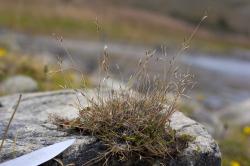- Taxon
- Gallery
Small low-growing olive-green tufted tussocks becoming pallid with many old small stramineous bladeless ligule-tipped sheaths below compact intravaginal innovations of 3–4 semipungent leaves ≪ culms; sometimes open and evidently stoloniferous, rooting and shooting at nodes. Prophyll 4–5 mm, keels weakly hairy, setae 0.5– 1 mm, finely hairy. Leaf-sheath 5–10 mm, usually glabrous but often long hairy, pale stramineous, shining, ridged, broader than leaf blade; adaxially with many fine hairs; apical tuft 0.5–0.75 mm, sparse, spreading. Ligule 0.2–0.3 mm, of fine hairs. Leaf-blade 10–25 mm × 2 mm, inrolled, glabrous, apex thickened and pointed, ciliate; disarticulating at ligule; adaxially very finely prickle-toothed on nerves; margins very finely antrosely prickletoothed; in TS central and main lateral vascular bundles with sclerenchyma girders, others free. Culm (2)–8–10–(20) cm, internodes smooth, shining; nodes 3–5, constricted, often geniculate below; inflorescence internode 3–7 cm, sheath sometimes with regular dark horizontal bands. Inflorescence a raceme or racemose panicle (0.5)–1–2–(3.5) cm of (2)–3–7 spikelets on very short branches or solitary; margins of rachis and branches very finely toothed; pedicels hairy, hairs denser and longer below spikelets. Spikelets 4–5 mm, of 3–5 small closely compact florets usually included by glumes, occasionally upper florets exerted. Glumes ≈, 4–5 mm, ± linear acute, faintly keeled, keels occasionally scabrid above, centrally purple or green, margins chartaceous, 3–5 nerves confluent above and central nerve excurrent; adaxially with abundant small white hairs. Lemma 1.5–1.75–2.25 mm, ovate, straw coloured and sometimes purpled above, 5–7 nerves anastomosing below sinus; dense long hairs in two rows ≤ lemma apex, upper row of irregular tufts, lower row of dense longer tufts reaching upper row, glabrous below lower row, single pair of marginal tufts at level of rachilla apex often extending below, adaxially finely hairy; apex tridentate with two short (0.2 mm) lateral lobes and finely ciliate mucro in sinus, 0.2–0.3–0.5 mm or absent, usually > lobes. Palea 1.5–2 mm, ≤ lemma rarely longer, keels toothed ± to base, interkeels and flanks glabrous, apex retuse. Callus 0.1–0.25 mm, rounded–obtuse, disarticulation oblique, marginal hair tufts 0.3– 0.5 mm overlapping lower lemma hairs. Rachilla (0.3)–0.4–0.5–(0.7) mm, glabrous. Lodicules 0.3 mm, cuneate, nerved, margins occasionally ciliate. Anthers (0.3)–0.4–0.75 mm, purple. Gynoecium: ovary 0.4–0.5 mm, stipitate; stigma–styles 0.75– 1 mm. Caryopsis 0.8–1.0 mm, stipitate, broadly ovate; embryo 0.4–0.5 mm; hilum 0.1–0.2 mm.
[Reproduced from Molloy & Connor (2005, New Zealand J. Bot. 43: 721–743) with permission from The Royal Society of New Zealand.]




